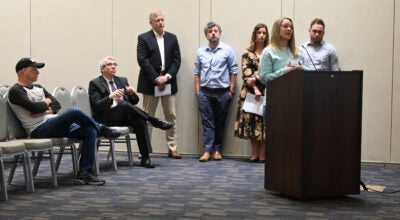Wineka column: Do dollar coins make sense?
Published 12:00 am Thursday, July 21, 2011
SALISBURY — Food Lion co-founder Ralph Ketner grew a company partly on building efficiencies into the culture and cutting out waste.
So you can imagine Ketner’s jaw dropping to the floor recently when he heard the Federal Reserve wants to spend $650,000 for a new vault in Dallas, so it has room for the presidential $1 coins that no one seems to be using.
Not only that, shipping all the extra $1 coins to the new facility would cost an additional $3 million.
If the U.S. Mint continues to make the $1 coins, as it is scheduled to do for the next five years, the Federal Reserve will have $2 billion in excess dollar coins, according to a government report.
Ketner’s solution is pretty simple: Kill the program and stop minting the nearly 2 million presidential coins daily.
He has dashed off a letter to U.S. Rep. Howard Coble, R-N.C., asking him to support a bill aimed at halting the program, which began issuing the presidential $1 coins in 2007.
“How stupid can we be to mint millions of these coins that citizens refuse to accept, and yet Congress refuses to ‘stop the presses,’ ” Ketner told Coble. “… PLEASE DO SOMETHING!!!”
Ketner resorted to those capitalized words and exclamation points for emphasis.
Coin collectors have known for a long time about the oversupply of presidential dollar coins, created by the 2005 law, the Presidential $1 Coin Act.
(Apparently, there is an oversupply of $1 Native American coins, too.)
The Federal Reserve’s Board of Governors in June released a report saying that few people want or use the coins, making the demand for them quite low.
Duh.
“To this day, cashiers at some retail stores still do not realize the coins are legal tender,” Louis Golino wrote Monday for the CoinWeek website, “and because businesses have the right not to accept certain forms of payments, such as bags of pennies, some do not even accept the coins.”
Golino added that many vending machines and parking meters have not been upgraded to accept dollar coins, and when most people receive them as change — which doesn’t happen often — they tend to save them.
On Facebook, Jerrie Neale Peeler told me, “I don’t use them, but I collect them. I am behind in my collection right now.”
Elizabeth Turneabe said she loves the $1 coins, “but everyone saves them!”
Some $1.25 billion in coins are sitting in Federal Reserve vaults right now.
From the 2005 legislation, banks are required to order new series of the coins during an introductory period. (Four new presidential $1 coins come out every year.) Because no one seems to like or use them, banks end up redepositing about 40 percent of the coins after the mandatory period.
Golino, the CoinWeek writer, says before people go screaming about the waste of taxpayer dollars, they should remember that no taxpayer money is used to fund the U.S. Mint, which is set up as a public enterprise fund receiving no annual appropriations.
As I do with most topics connected to money, I turned to my family for answers. They are expert spenders.
“It’s too much like a quarter,” my wife explained of the $1 coin’s failure to catch on.
And there’s a lot of truth in that, except that the presidential coins are gold not silver. Still, they are only slightly bigger than a quarter, and we apparently would rather fold bills into our wallets than have dollar coins jangling in our pants pockets.
If I’m not mistaken, Canada went to $1 coins a long time ago, and euros come in $1 and $2 coin denominations.
My oldest son, Sam, traveled extensively through Europe, like many college kids do.
“While it has been a few years,” said Sam, now 25, “I do remember thinking while I was over there that coins made much more sense. Once you’re acclimated to using them it’s much easier.”
He said he also noticed that European men’s wallets often include a small pouch for coins. Sam suggested that might be a reason U.S. men have been slow to adapt.
“(We) certainly don’t want to appear unmanly with our change purses,” he said.
Sam now works in Washington, D.C., where the Metro kiosks will give you change in the $1 coins.
“I personally avoid them because they can add up to a big, jangling pocket,” he said, “but if I do end up with some, I just try and spend them as soon as possible. I guess they don’t particularly bother me, but I prefer bills.”
I conducted a mini-experiment of my own Thursday morning. I walked into the downtown Wachovia and F&M banks and asked tellers at each location for $5 worth of presidential $1 coins.
They quickly met my request, and even tried to give me as many different dead presidents as they could. (A president has to be dead to be commemorated on the $1 coins).
I now have 10 fairly shiny $1 coins on my desk, and I’m wondering what to do with them. I noticed that our soft-drink vending machine on the third-floor break room says “Deposit nickels, dimes and quarters.”
No mention of $1 coins.
If it’s any consolation to Ketner, the $1 coins were actually meant to save money. Dollar coins last longer — 30 years or more, as compared to dollar bills, which wear out in an average of 21 months.
Even if they cost more to produce, the $1 coins make that up several times over, just through longevity.
Past government studies determined that replacing dollar bills with dollar coins would save the government $500 million to $1 billion a year. But for Americans to accept $1 coins and begin using them will take a decision no one in Washington has the guts to make:
Stop printing dollar bills.
You’d be surprised how quickly we would adapt to spending $1 coins. Meanwhile, I have 10 dead presidents staring at me.
Contact Mark Wineka at 704-797-4263, or mwineka@ salisburypost.com.





